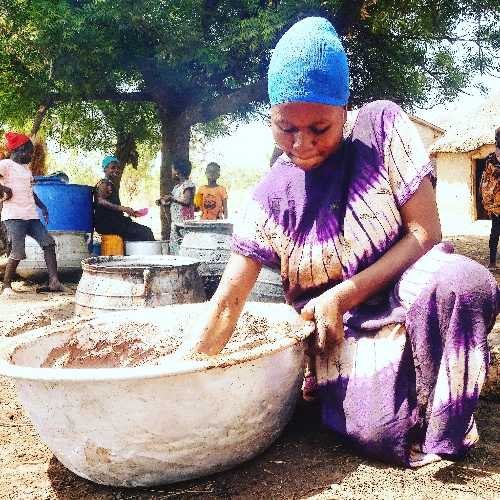Butter: Shea Natural Yellow
Traditional African Yellow Shea Butter is Fair Trade Sourced from Ghana community projects that Empower Women...
Shea butter is especially good at healing cracked slow-to-heal skin, such as heels, and elbows and where circulation is low, such as with elderly, rheumatic, arthritic or diabetic persons. The addition of borututu Cochlospermum angolense bark enriches yellow shea butter with sun screening, skin healing anti oxidant carotenoids. In Ghana, where the bark locally known as paajawu, it is added to shea butter during the boiling process, resulting in vibrant yellow colouring.
Common Uses
• Lip balms
* Light sun protection
• Body & massage butter
• As an oil in the body and hand Lotions
• Shaving preparations
• Facial moisturizers
• Bath products...
Used in skin care, shea butter is hailed for its protecting and emollient properties. Rich in cinnamon acid, it also protects the skin from UV rays and therefore can be included in skin care products for the sun. It can also be used as a massage butter, as a moisturizing agent in soaps and shaving creams, and as a treatment for minor skin wounds and irritations. Its richness and skin healing and nourishing properties make it perfect for healing dry, cracked heels.
Botanical Name: Vitellaria paradoxa formerly known as Butyrospermum parkii or Butyrospermum paradoxum
There are TWO kinds of virgin natural grade A fairly traded shea butter at Anarres to choose from:
THIS YELLOW ONE:
$5/100g Ghana Organic yellow coloured
$22.50/500g 10% off
$40/1000g 20% off
GO HERE for Ivory Unrefined Shea Butter (uncoloured without Borututu Root)
The kinds of shea butter at Anarres are:
* Fairly traded, made by women's cooperatives and certified by the Shea Butter Alliance
* 100% natural & unrefined
* Undyed and not bleached
* Extracted by kneading with water, not hexane or other solvents
* Purified at low heat using clays, not chemicals or high heat
* Made from ripe karite tree nuts.
Resulting in a smooth, buttery natural moisturizer, skin healer and sunscreen.
Aroma: Characteristic nutty, with citrus notes. Traditionally prepared & fermented varieties smell stronger.
HISTORY
Shea butter has been a precious commodity on record since Ancient Egypt, where shea butter was and continues to be used to protect the hair and skin against the fierce sun and the hot dry winds of African deserts and savannah. I believe that shea butter was exported from the ancient Ethiopian empires of Punt (Sudan) and Sheeba (Ethiopia). Trade across the African continent from the East African civilizations to West Africa has been continuous for thousands of years. Thus the West African shea butter (Burkina Faso, Togo, Ghana etc) continue the tradition of Ancient Ethiopia.

HOW SHEA BUTTER IS MADE
Shea butter is crafted through a painstakingly laborious process, even when machines are used for some steps.
Remove the outer pulp. Sometimes shea nuts are fermented first.
Separate the dry nut from its outer shell.
Crush the shea nuts.
Roast the shea nuts.
Grind the shea nuts into a paste.
Extract the butter by kneading and adding water.
Squeeze the water out of the butter curds.
Melt the shea curds over a slow fire, evaporating out any remaining water.
Ladle out the shea butter and allow to cool, then form into balls.

Photo thanks to Araphat Abass - Own work, CC BY-SA 4.0, Link
The kinds of shea butter we carry are always Grade A 100% Natural & Unrefined, undyed Shea Butter from RIPE karite tree nuts! The trees are organically farmed and nuts are most often wildcrafted.
Why I don't carry or use white deodorized shea butter
Plants make aromas, pigments, and anti oxidants like vitamine E as medicine to protect themselves, to heal and to communicate. Bleaching and deodorizing remove these medicines, and the resulting fat will not have the benefits that you expect.
Natural Shea Butter Applications
• As a natural anti-sun damage ingredient @SPF 15
• As a skin healing agent for small wounds & cracks
• As an anti-ageing agent for the skin
• To soothe sunburns
• To treat dry, damaged hair
• To soothe aching muscles
How much should I use in my products?
I suggest adding 10-20% shea butter to carrier oil, lotion, balm or cream. When melted and blended into lotion at 20%, the mixture will set into a cream.
Fair Trade Compliant
My supplier sources its products using ethical suppliers. Both the shea and cocoa butter are fair trade compliant. This means that profits go back to the community, that environmentally friendly production methods are utilized, that underage or forced labour is not used, and that a minimum price is paid to the producers regardless of market pressure.
Lead photo thanks to daveynin 100% Natural African Shea Butter on Flickr.




